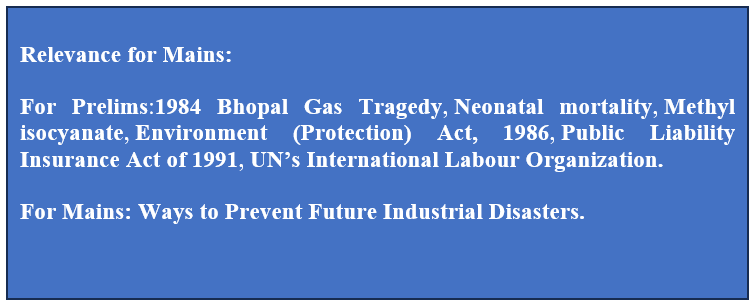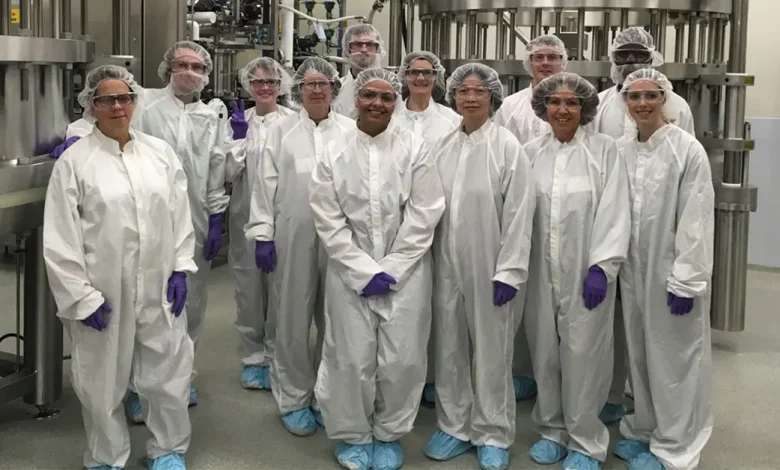- Courses
- GS Full Course 1 Year
- GS Full Course 2 Year
- GS Full Course 3 Year
- GS Full Course Till Selection
- Online Program
- GS Recorded Course
- NCERT (Recorded 500+ Hours)
- Polity Recorded Course
- Geography Recorded Course
- Economy Recorded Course
- AMAC Recorded Course
- Modern India, Post Independence & World History
- Environment Recoded Course
- Governance Recoded Course
- Science & Tech. Recoded Course
- International Relations and Internal Security Recorded Course
- Disaster Management Module Course
- Ethics Recoded Course
- Essay Recoded Course
- Current Affairs Recoded Course
- CSAT
- 5 LAYERED ARJUNA Mentorship
- Public Administration Optional
- ABOUT US
- OUR TOPPERS
- TEST SERIES
- FREE STUDY MATERIAL
- VIDEOS
- CONTACT US
Persistent Health Effects of Bhopal Gas Tragedy
Persistent Health Effects of Bhopal Gas Tragedy
17-06-2023

Latest Context:
Recently, a study highlighted the continuous health issues faced by individuals even after decades of Bhopal Gas Tragedy event.
Main Findings of the Study are:
- As per the study, it has been observed that the impacts of the tragedy are visible in almost 100 km radius around Bhopal, affecting big area than previously assessed.
- Study also mentioned the social costs associated with the event, which still continue to affect generations.
- Many survivors of the Bhopal Gas Tragedy have experienced a lot of health problems over the years and these include respiratory, neurological, musculoskeletal, ophthalmic (related to eyes), and endocrine issues.
- A big increase in miscarriages, stillbirths, neonatal mortality, menstrual abnormalities, and premature menopause has been observed among womens who have been exposed to the toxic gas.
- Women who were residing within 100 kms of Bhopal and were pregnant with male foetuses had a 1% point higher disability rate.
- Decline in the proportion of male child births from 64% (1981-1984) to 60% (1985) have been observed among womens living within 100 km of Bhopal.
About the Bhopal Gas Tragedy
- The Bhopal Gas Tragedy, also known as the Bhopal disaster, took place on the night of December 2-3rd 1984, in Bhopal, Madhya Pradesh.
- It was caused by a massive release of toxic gases from the Union Carbide India Limited (UCIL) pesticide plant, which was owned by Union Carbide Corporation (UCC), a multinational company based in the United States.
- The disaster occurred when a highly toxic gas called Methyl Isocyanate (MIC) was released from a storage tank at the UCIL plant.
- The exact cause of the gas release is still a matter of debate, but it is believed to have been triggered by a combination of factors, including poor maintenance practices, inadequate safety measures, and equipment failures.
- The gas leak quickly spread over the surrounding residential areas, exposing thousands of people to the toxic gases. The immediate effects were catastrophic, resulting in the deaths of thousands of people within the first few days.
- The exact death toll remains a matter of contention, with estimates ranging from a few thousand to as high as 15,000.
- In addition to the fatalities, hundreds of thousands of people were injured, many of whom suffered long-term health consequences.
- The toxic gases caused severe respiratory problems, eye disorders, neurological damage, and other health issues among the survivors.
- The impact on the environment was also significant, with long-term contamination of soil and water resources in the vicinity of the plant.
Preventing future industrial disasters requires a comprehensive approach that involves multiple stakeholders, including governments, industries, regulatory bodies, and communities. Here are some key strategies and measures that can help prevent industrial disasters:
-
Strict Regulatory Frameworks: Governments need to establish and enforce robust regulatory frameworks that set clear standards for industrial safety. These regulations should cover various aspects, such as design and construction of facilities, equipment maintenance, emergency response plans, and worker safety. Regular inspections and audits should be conducted to ensure compliance.
-
Risk Assessment and Management: Industries should conduct thorough risk assessments to identify potential hazards and vulnerabilities in their operations. This includes evaluating the likelihood and potential impact of accidents or releases of hazardous substances. Based on these assessments, appropriate risk management measures, such as safety protocols, redundant systems, and preventive maintenance, should be implemented.
-
Training and Education: Adequate training and education are crucial for workers and management to understand and follow the safety protocols. This includes providing comprehensive training on equipment operation, emergency response procedures, hazard recognition, and safety protocols. Ongoing training and refresher courses should be provided to ensure knowledge and skills are up to date.
-
Safety Culture: Fostering a strong safety culture within organizations is vital. This involves promoting a mindset where safety is prioritized at all levels of the organization, from top management to front-line workers. Encouraging open communication and continuous improvement of safety practices can contribute to a strong safety culture.
-
Technology and Automation: Embracing technological advancements and automation can enhance industrial safety. Implementing state-of-the-art monitoring systems, sensors, and automation controls can help identify and address potential risks in real-time. Automation can reduce human error and minimize the risk of accidents caused by manual operations.
-
Community Engagement: Industrial facilities must actively engage with local communities and address their concerns. Establishing effective communication channels, conducting community awareness programs, and involving community representatives in decision-making processes can foster trust and collaboration. This engagement can help identify potential risks and mitigate their impact on nearby populations.
-
Independent Audits and Oversight: Independent audits and oversight play a crucial role in ensuring compliance with safety regulations. Regular inspections and audits by qualified external agencies can provide unbiased assessments of industrial facilities. This helps identify gaps in safety practices, ensures adherence to regulations, and holds industries accountable for maintaining safe operations.
-
International Cooperation: Collaboration between countries, regulatory bodies, and industries at the international level is essential. Sharing best practices, research, and technological advancements can help improve industrial safety globally. International standards and guidelines can be developed to promote uniformity in safety practices and prevent incidents caused by inadequate regulations.
Conclusion:
Preventing industrial disasters requires a proactive and ongoing commitment from all stakeholders involved. It is a collective responsibility to prioritize safety, implement robust preventive measures, and continuously improve industrial practices to mitigate the risks associated with industrial operations.



